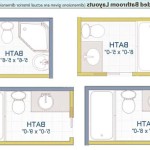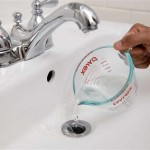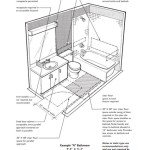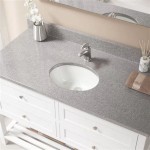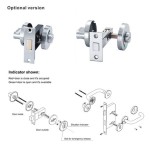Wall-Hanging Bathroom Vanity Cabinets: A Contemporary Space-Saving Solution
Wall-hanging bathroom vanity cabinets, also known as floating vanities, are increasingly popular fixtures in modern bathroom design. These units are mounted directly to the wall, leaving the floor beneath them exposed. This design choice offers significant functional and aesthetic advantages over traditional floor-standing vanities, contributing to a more spacious, hygienic, and visually appealing bathroom environment. This article will comprehensively examine the features, benefits, design considerations, installation aspects, and maintenance requirements of wall-hanging bathroom vanity cabinets.
Space Optimization and Enhanced Accessibility
One of the primary advantages of a wall-hanging vanity cabinet is its optimization of bathroom space. By eliminating the footprint that a traditional vanity occupies on the floor, the room immediately appears larger and less cluttered. This is especially beneficial in smaller bathrooms where maximizing available square footage is crucial. The open space beneath the vanity allows for easier movement and maneuverability, making the bathroom more user-friendly for individuals with mobility issues. Furthermore, the visible floor area facilitates more efficient cleaning. Mops, brooms, and vacuum cleaners can easily reach under the vanity without the need for awkward bending or maneuvering around a cabinet base. This contributes to improved hygiene and sanitation within the bathroom.
Beyond simply creating a sense of spaciousness, the open area beneath a wall-hung vanity can also be functionally utilized. Depending on the height at which the vanity is mounted, it can provide storage space for items such as baskets, decorative containers, or even small stools. This extra storage capacity can be particularly valuable in bathrooms with limited storage options elsewhere. The height of installation also allows for customization to suit individual needs and preferences. A higher mounting point may be preferable for taller individuals, while a lower mounting point might be more appropriate for families with young children.
The choice to install a wall-hung vanity is a deliberate strategic design decision to maximize space and improve the overall user experience. The visual lightness they create contributes to a more open and airy atmosphere, enhancing the overall aesthetic appeal of the bathroom. In summary, the spatial benefits of these vanities include:
- Illusion of a larger space due to exposed floor area.
- Improved accessibility for cleaning.
- Potential for additional storage beneath the unit.
- Customizable mounting height for user comfort.
Design Versatility and Aesthetic Appeal
Wall-hanging bathroom vanity cabinets offer a wide range of design options to complement various bathroom styles and preferences. They are available in numerous materials, finishes, sizes, and configurations, allowing homeowners to select a unit that perfectly integrates with their existing decor. Material choices range from solid wood, known for its durability and natural beauty, to engineered wood products like MDF or plywood, which offer cost-effectiveness and moisture resistance. Countertop options further expand the design possibilities, with choices including granite, quartz, marble, ceramic, glass, and solid surface materials. Each material brings its unique characteristics to the overall aesthetic, influencing the look and feel of the bathroom.
The finish options for wall-hanging vanities are equally diverse, encompassing a wide spectrum of colors, textures, and sheen levels. From sleek and modern high-gloss finishes to rustic and textured wood grains, there is a finish to suit every taste. Hardware choices, such as knobs, pulls, and handles, also play a significant role in the overall design. These seemingly small details can have a profound impact on the style and character of the vanity, ranging from minimalist and contemporary to ornate and traditional.
Furthermore, wall-hung vanities are available in various configurations, including single and double sink models, as well as different cabinet door and drawer arrangements. The choice of configuration depends on the space available and the user's storage needs. For example, a double sink vanity might be ideal for a master bathroom shared by two individuals, while a single sink vanity might be more appropriate for a smaller guest bathroom. The flexibility in design and customization makes these vanities a versatile choice for any bathroom renovation or new construction project. Some common design elements and benefits include:
- Wide variety of materials, finishes, and hardware options.
- Adaptability to different bathroom styles (modern, traditional, minimalist, etc.).
- Customizable configurations to suit individual needs.
- Enhanced visual appeal compared to traditional floor-standing vanities.
Installation and Structural Considerations
The installation of a wall-hanging bathroom vanity cabinet requires careful planning and execution to ensure structural integrity and long-term stability. Unlike floor-standing vanities, which distribute their weight across the floor, wall-hung vanities rely solely on the wall for support. Therefore, it is crucial to properly secure the vanity to the wall studs or a reinforced backing behind the drywall. Failure to do so can result in the vanity sagging over time and potentially detaching from the wall, causing damage and injury.
Before installation, it is essential to locate the wall studs and determine their spacing. Most residential walls are built with studs spaced 16 or 24 inches apart. The mounting brackets for the vanity must be securely attached to the studs using appropriate hardware, such as lag screws or heavy-duty bolts. If the studs are not located in the optimal positions to support the vanity, it may be necessary to install a horizontal ledger board or a reinforced backing behind the drywall. This provides a solid surface for attaching the mounting brackets and distributing the weight of the vanity more evenly.
It is strongly recommended to consult with a qualified contractor or plumber during the installation process, particularly if you are not experienced with home improvement projects. A professional can ensure that the vanity is properly installed and that all plumbing connections are made correctly. Improper plumbing connections can lead to leaks, water damage, and costly repairs. The installation process typically involves these key considerations:
- Proper wall stud location and support.
- Secure mounting bracket attachment.
- Accurate plumbing connections for water supply and drainage.
- Leveling and alignment of the vanity.
- Potential need for professional installation.
The weight of the vanity itself, as well as the weight of the countertop, sink, and any items stored inside, must be taken into account when determining the appropriate mounting hardware and support system. Overloading the vanity can compromise its stability and potentially lead to structural failure. Regular inspections of the mounting hardware are recommended to ensure that it remains tight and secure over time. If any signs of loosening or damage are detected, the hardware should be replaced immediately to prevent accidents.
In addition to structural considerations, it is also important to consider the plumbing requirements for a wall-hung vanity. The water supply lines and drainpipe must be routed through the wall and connected to the sink and faucet. This may require adjustments to the existing plumbing infrastructure, depending on the location of the vanity and the existing plumbing layout. It is crucial to ensure that all plumbing connections are properly sealed to prevent leaks and water damage. Flexible supply lines and drainpipes can simplify the installation process and allow for greater flexibility in positioning the vanity. However, it is essential to use high-quality materials and follow all applicable plumbing codes to ensure a safe and reliable installation.
The process of correctly installing a wall-hung vanity involves a detailed plan of execution. The importance of professional help is paramount for safety and damage prevention.
Wall Mounted Hanging Floating Bathroom Vanity Cabinet Tw 2203

Upiker Modern 18 In W X 24 D 20 5 H Wall Hung Bath Vanity Cabinet With Top Light Oak Up2209bcl24002 The Home Depot

Elegant Wall Mounted White Bathroom Vanity Unit And Sink Basin Home Furniture

Wall Mounted Bathroom Vanity In Dark Cherry Decora

White Pvc Bathroom Cabinet European Modern Wall Hung Vanity China Made In Com

Class Wall Hanging Washbasin Vanity Cabinet Set Of 3 By Tgf Lorange Com

Fiona Wood Bathroom Vanity With Sink Vanities

30 Gray Wall Hung Vessel Sink Modern Bathroom Vanity With Medicine Cabinet

Modern 39 Floating Black Bathroom Vanity Stone Top Wall Mounted Cabinet Interior Design

Wall Hung Vanities Vs Freestanding What S Right
Related Posts
